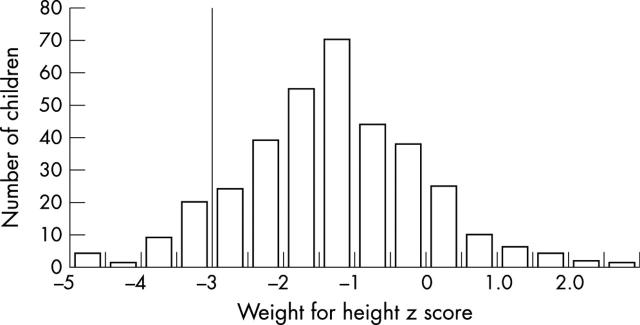Abstract
Aim: To test whether nurses can use the WHO integrated management of childhood illness (IMCI) nutrition algorithm to identify reliably severe protein-energy malnutrition in children.
Methods: Nurses were trained to identify severe protein-energy malnutrition using IMCI training materials. They identified visible severe wasting and bipedal oedema, and categorised weight-for-age using a growth chart, in consecutive children attending outpatient clinics. Their findings were compared with weight for height Z (WHZ) score, bipedal oedema assessed by a trained observer, and weight-for-age Z score.
Results: A total of 352 children were recruited, of whom 34 (9.7%) were severely wasted (WHZ score <-3) and 18 (5.1%) had bipedal oedema. In the detection of severe wasting, the nurses' assessments showed 56% sensitivity, 95% specificity, and 56% positive predictive value (PPV), and for bipedal oedema 22%, 99%, and 57% respectively. Overall, the nurses identified only half of 50 children with severe wasting and/or bipedal oedema and wrongly identified a further 13 children as severely malnourished. Plotting weight for age by the nurses showed 62% sensitivity, 99% specificity, and 89% PPV for the detection of children with very low weight.
Conclusions: Severe malnutrition was both under-diagnosed and wrongly diagnosed by nurses trained in the use of the IMCI nutrition algorithm in a clinic setting in The Gambia. These guidelines for health workers and the training materials, particularly with respect to calculation of age, need further development to improve the detection of malnourished children.
Full Text
The Full Text of this article is available as a PDF (175.8 KB).
Figure 1 .
Distribution of weight for height Z score in 352 children. The vertical line is the cut off line for severe malnutrition: WHZ score <-3.
Selected References
These references are in PubMed. This may not be the complete list of references from this article.
- Bern C., Zucker J. R., Perkins B. A., Otieno J., Oloo A. J., Yip R. Assessment of potential indicators for protein-energy malnutrition in the algorithm for integrated management of childhood illness. Bull World Health Organ. 1997;75 (Suppl 1):87–96. [PMC free article] [PubMed] [Google Scholar]
- Chen L. C., Chowdhury A., Huffman S. L. Anthropometric assessment of energy-protein malnutrition and subsequent risk of mortality among preschool aged children. Am J Clin Nutr. 1980 Aug;33(8):1836–1845. doi: 10.1093/ajcn/33.8.1836. [DOI] [PubMed] [Google Scholar]
- Gayle H. D., Binkin N. J., Staehling N. W., Trowbridge F. L. Arm circumference v. weight-for-height in nutritional assessment: are the findings comparable? J Trop Pediatr. 1988 Oct;34(5):213–217. doi: 10.1093/tropej/34.5.213. [DOI] [PubMed] [Google Scholar]
- Gove S. Integrated management of childhood illness by outpatient health workers: technical basis and overview. The WHO Working Group on Guidelines for Integrated Management of the Sick Child. Bull World Health Organ. 1997;75 (Suppl 1):7–24. [PMC free article] [PubMed] [Google Scholar]
- Man W. D., Weber M., Palmer A., Schneider G., Wadda R., Jaffar S., Mulholland E. K., Greenwood B. M. Nutritional status of children admitted to hospital with different diseases and its relationship to outcome in The Gambia, West Africa. Trop Med Int Health. 1998 Aug;3(8):678–686. doi: 10.1046/j.1365-3156.1998.00283.x. [DOI] [PubMed] [Google Scholar]
- Pelletier D. L., Frongillo E. A., Jr, Schroeder D. G., Habicht J. P. The effects of malnutrition on child mortality in developing countries. Bull World Health Organ. 1995;73(4):443–448. [PMC free article] [PubMed] [Google Scholar]
- Schofield C., Ashworth A. Why have mortality rates for severe malnutrition remained so high? Bull World Health Organ. 1996;74(2):223–229. [PMC free article] [PubMed] [Google Scholar]
- Simoes E. A., Desta T., Tessema T., Gerbresellassie T., Dagnew M., Gove S. Performance of health workers after training in integrated management of childhood illness in Gondar, Ethiopia. Bull World Health Organ. 1997;75 (Suppl 1):43–53. [PMC free article] [PubMed] [Google Scholar]



